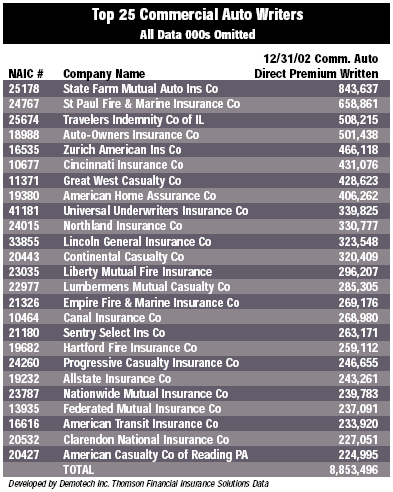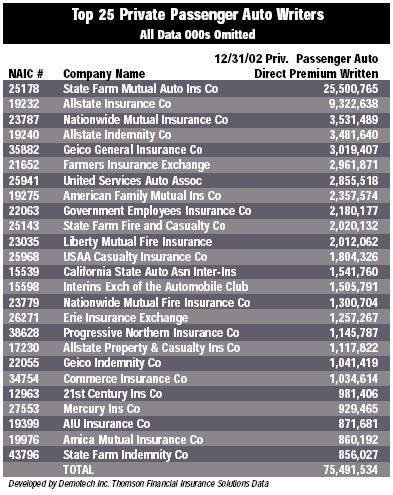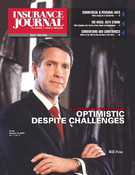The auto insurance market has come a long way since Travelers wrote the first third-party policy for Gilbert J. Loomis’s one-cylinder car in 1897.
“I’ll never insure a gasoline can on wheels,” declared Insurance Company of North America President Charles Platt, as reported by insurance historians Jack Bogardus and Robert Moore in a recent article. Given the mounting loss ratios thanks to medical inflation, drowsy truck drivers and very restrictive rate regulation in certain states, many insurers may share Platt’s sentiment. But no one will stop them trying to make a buck, as rates for commercial and personal—or private passenger—auto continue to rise, though at more moderate rates than since the market hardened.
Robert Hartwig, chief economist at the industry-funded New York City-based Insurance Information Institute (III), told Insurance Journal that he estimates personal auto rates will rise by an average of 4 to 5 percent nationally in 2004, a slight moderation from the 8.5 percent jump in 2003. He based the estimate on an analysis of insurers’ rate-filing activity as well as the U.S. Bureau of Labor Statistics’ Consumer Price Index data relating to auto insurance.
Hartwig’s analysis estimates that the average amount spent on personal auto insurance has increased from $687 in 2000 to a projected $898 in 2004, a 30 percent increase since the market turned. The soft market between 1995 and 2000 saw auto insurance spending vary slightly, hopping by only about 3 percent during the period. Hartwig pins the blame for rising rates on predictable villains: medical inflation, high vehicle repair costs, jury awards and fraud. The average jury award in vehicular liability cases rose 70 percent to $323,236 from 1995 to 2001, according to Horsham, Pa.-based Jury Verdict Research. In 1996, the industry-funded Insurance Research Council (IRC) estimated that fraud added as much as $6.3 billion to the premiums policyholders pay annually.
Meanwhile, an IRC study of 70,000 auto claims released last month showed that while auto injuries were less severe, they were more costly. According to the study, “Auto Injury Insurance Claims: Countrywide Patterns in Treatment, Cost and Compensation,” average personal-injury protection (PIP) losses increased from $4,804 in 1997 to $6,711 in 2002. Medical payments losses rose from $3,348 to $4,621. Both increased 7 percent on an annualized basis since 1997.
So there is definitely some truth to Hartwig’s argument, but it leaves out the industry’s poor investment income as a factor.
“Most auto insurers have their investments in bonds,” according to Tom King, treasurer for leading vehicle insurer Progressive Corp., based in Ohio. “Bond yields are near-record lows so that will mitigate temptation for cash-flow underwriting.” King said that 85 percent of Progressive’s portfolio, for example, is in fixed-income securities.
In response, auto insurers have put more of an emphasis on making an underwriting profit, which means tightening standards and charging higher rates. This explains the trend since 2001, and though stocks spurred by very solid earnings reports and a global economic recovery have soared to their highest levels since Sept. 11, 2001, it seems unlikely that auto insurers will allow these factors to interfere with their renewed commitment to profits on underwriting alone.
“It’s a good bet that rate decreases won’t happen in 2004 because of fear of regulatory freeze,” according to Brian Sullivan, editor of Auto Insurance Report. “Nationally, the first half of 2004 is already in the books in the sense that if you took a rate decrease tomorrow it wouldn’t have an impact. … Pricing won’t change radically until 2005.”
Sullivan said he expects that competition for market share will come in stepped up advertising and, later perhaps, looser underwriting. Only after those two aggressive measures have been tried will insurers begin to ponder lower rates. “It doesn’t mean there won’t be more competition, it just won’t be on price,” he said.
For reasons of state
This big-picture view of matters inevitably misses the variation in auto rates and availability from state to state caused principally by traffic density, but also by three seemingly inescapable sources of mischief—criminals, lawyers and politicians.
Major auto fraud rings have plagued huge markets such as New York, California, Massachusetts and Florida. In 2001, III estimated that fraud cost each insured driver in New York as much as $115 a year in premiums, while the average PIP claim there—47 percent higher than the national average; premiums rose by 25 percent. Poorly formulated no-fault systems—where insurers pay each party’s damages and no attempt to determine legal fault for a collision is made—have made auto insurance fraud a profitable business, according to III’s Hartwig.
“As the rest of the world has gone to managed care or HMOs where medical costs are monitored, the problem with no-fault states they are a relic,” he said. “They have this fee-for-service type of arrangement not found anywhere else, not even in workers’ compensation. The last open-rate checkbook in America today is in auto insurance policies. It has opened the door to fraud and abuse to the extent that organized crime has set up shop in places like New York and Massachusetts to stage bogus accidents.”
Two Northeastern states—New Jersey and Massachusetts—have long stood out as having the most over-regulated auto insurance markets, especially since flex-band rating changes were adopted in South Carolina and Louisiana. While New Jersey appears to have made major steps toward reforming its market, industry lobbyists hope at most for “teeny tiny baby steps” toward progress in the Bay State.
New Jersey, led by Democratic Gov. James McGreevey, passed legislation last year to overhaul the state’s ailing market. Seven carriers had pulled out in 2002 alone and 27 had pulled out in the last decade. When captive agency company State Farm—the top personal auto writer in the country—announced its plans to leave, the politicians got serious.
The reforms expedited the state’s prior-approval rating process, pledged to eliminate the take-all-comers law by 2009, and reformulated the regulations regarding carriers’ “excess profits.” However, much of the hard work of the law was left to insurance department regulators to sort out, and while 20 regulations have been issued so far and 11 adopted since the beginning of the year, insurers remain cautious.
AIG has decided to put off leaving the market for two years, and State Farm has stopped nonrenewing 4,000 auto policies a month. One company, California-based Mercury General Insurance Group, has even entered the market, and McGreevey boasted in a news release that auto carriers have appointed 500,000 new agents since the legislation passed. However, other major auto insurers such as Berkshire Hathaway captive-agent subsidiary GEICO have stayed away so far.

“We’re not surprised that marketplace has had these reactions,” said Richard Stokes, a New Jersey lobbyist for the Property Casualty Insurance Association of America (PCI). “We’re more surprised how quickly these things have started. Others are in wait-and-see mode because in politics things can change overnight. But we think the department’s reactions to S. 63 [the reform legislation] has been very positive.”
Progressive, which distributes two-thirds of its products through independent agents, has not written coverage in New Jersey for at least 15 years, according to Treasurer Tom King.
“But,” he said, “if we gain confidence that we can meet our underwriting targets, we’d be excited about entering. In any jurisdiction we want to comply with the law and meet our financial targets.”
Auto Insurance Report’s Sullivan said “the New Jersey legislative changes were exactly what the market needed, however we’re still waiting for the final implementing regulations to be completed so no one can be certain we have a victory yet. That’s why Progressive isn’t there yet and GEICO isn’t there yet. Other companies are still being very tentative. While it looks good, they haven’t proven that it’s a done deal.”
Mass. confusion
While change isn’t yet complete in New Jersey, it has barely begun in Massachusetts. In spite of a recently announced average rate increase of 2.5 percent for 2004, only 19 auto insurers write in the Bay State, and five of those write less than 1 or 2 percent of the market, according Massachusetts Insurance Division spokesman Chris Goetcheus. Meanwhile, 7.5 percent of the market is written through the state’s assigned-risk pool, compared to a 1.5 percent average nationally.
“Massachusetts continues to have the most anti-competitive regulatory system and one of the worst in the world,” according to Dave Snyder, assistant general counsel for the Washington, D.C.-based American Insurance Association. “While a little rate increase is helpful, Massachusetts needs to rip up its system and start anew.

“Much more needs to be done to make Massachusetts better serve its consumers and bring in fairness and competition in auto insurance,” Snyder added. “Its system is loaded with subsidies of high-risk drivers with the state setting the rates, which really marks it as one of the last jurisdictions anywhere on the globe that doesn’t allow the market to set rates—and that includes most of Europe, Latin American and Southeast Asia.”
Massachusetts is the only state to operate under the fix-and-establish, which calls for the insurance commissioner to first determine whether the market is competitive. If it is deemed uncompetitive, the commissioner then sets the rates. When was the last time a Bay State commissioner deemed the market “competitive” and so, you know, actually let carriers compete on rate? Let’s put it this way. Back then, the Star Wars movies being released were actually entertaining.
“It’s almost like communism,” said Neil Alldredge, a lobbyist for Indianapolis-based National Association of Mutual Insurance Cos., which has several members who still write auto coverage in the state. “You’re told how much it costs to do business, so how can you have a competitive market? A company there has told me that under the rating system the best possible combined ratio they could have achieved in Massachusetts last year was 109,” thus automatically losing nine cents on the dollar. “To me, that’s a signal the system is in need a change. You can see how backwards it is.”
Republican Gov. Mitt Romney did call attention to the problem in his State of the State address last month and said “this is the year for auto insurance reform,” but there are no signs yet that the liberal legislature will take action.
“My personal opinion is that Massachusetts is not in the crisis atmosphere necessary for wholesale changes in the market,” Sullivan said. “Insurers are unhappy and not making very much money, but the problem is most of the state is dominated by domestic insurers. There’s no place to go. As long as they’re not going bankrupt—one has—the state can keep skating by with this weirdo system.
“New Jersey didn’t change until State Farm started to walk,” Sullivan noted. “People have been complaining for decades and decades about New Jersey, but that’s when things changed and not until then.”
Keep on truckin’ (for half a day)
Things have changed in the commercial auto market, which is predominantly composed of insuring trucking fleets. After three years of contentious and politically-sensitive debate, the Federal Motor Carrier Safety Administration—a part of the U.S. Department of Transportation (DOT)—issued new rules regulating how many hours truckers can drive in a day. Truckers are no longer allowed to drive more than 12 hours in a 24-hour period and must start their driving at the same time each day.
The rules, supported by safety advocates and insurers but opposed trucking companies, may have some effect in commercial auto loss ratios down the line and eventually be factored into rates, but most observers agree the immediate impact will be negligible.
III’s Hartwig said the rules “could be relatively easy to flaunt,” while Dave Golden, commercial lines manager for PCI, said “drivers’ log falsification has been an issue of contention and discussion for many years.”
The beneficial impact of the regulation is questionable, according to Golden, who said the DOT estimated that only 75 lives would be saved every year as a result. “Overall, you’re looking at a small enough change that this alone is not going to have a large impact on how insurance for truckers is priced,” he said.
In spite of that, Golden said “the marketplace this year looks like we’re going to continue to see a moderating of the size of increases. It may even be flattening out.” Things did not look so rosy to Howard Nenner, the New Jersey-based head of the transportation specialty within the Hub International Ltd. brokerage.
“The issues that exist in trucking over the past year and even beyond that are as prevalent as ever,” he said. “First there’s the lack of qualified drivers, then there’s a continuance of increase in rates. There’s a diminished amount of markets even though other aspects of insurance business have started to see rate stabilization and declining rates. It’s the opposite for transportation.”
Nenner attributed the situation to the severity of claims and to “insurance companies not willing to risk underwriting profit for a very hazardous class of business. They’re not getting the rate of return on their investments. All those things make it an ugly picture for transportation.”
He pointed to Phoenix-based Republic Western Insurance Co. as an example of a company that was once “A”-rated whose A.M. Best financial-strength rating has fallen to “C.” Another example is New York-based Clarendon Insurance Group which stopped writing new business and has begun nonrenewing commercial auto policies, according to Nenner.
“A lot of people that specialize in trucking—when times are good they’re trying to raise money and the first thing they can do is write trucks—when it gets tough, when investment dollars aren’t there and they’re looking for underwriting profit to sustain business … what’s left is the true people who specialize in it day to day.”
Whether the good news on Wall Street changes this picture anytime soon may be better left to those with a crystal ball. My magic-eight ball says, “I’ll get back to ya.”
Topics Carriers Auto Legislation Profit Loss Fraud Commercial Lines New York Underwriting Business Insurance New Jersey Trucking Massachusetts
Was this article valuable?
Here are more articles you may enjoy.


 Howden Buys M&A Insurance Broker Atlantic Group in US Expansion
Howden Buys M&A Insurance Broker Atlantic Group in US Expansion  Howden US Tells Judge Brown & Brown Employees Fled Due to ‘Mistreatment’
Howden US Tells Judge Brown & Brown Employees Fled Due to ‘Mistreatment’  Florida Insurance Agency VP Sentenced to 3 Years in Massive ACA Fraud Scheme
Florida Insurance Agency VP Sentenced to 3 Years in Massive ACA Fraud Scheme  ’60 Minutes’ Homeowners Ask Court to Force DFS to Divulge Heritage Probe Info
’60 Minutes’ Homeowners Ask Court to Force DFS to Divulge Heritage Probe Info 


